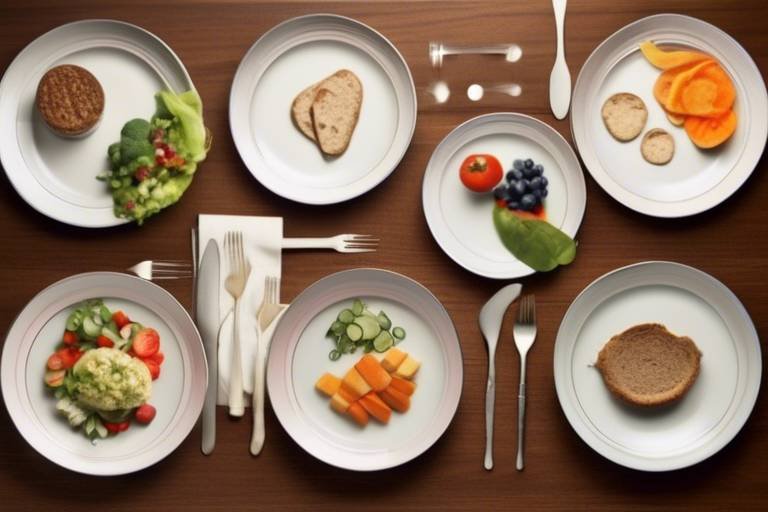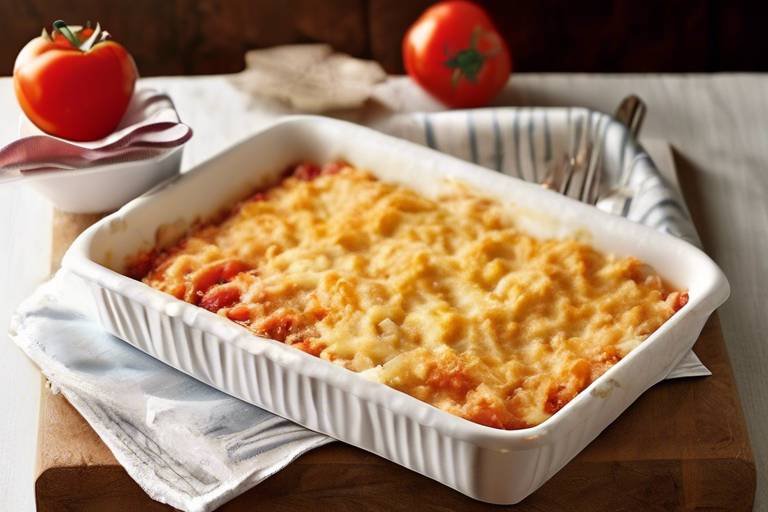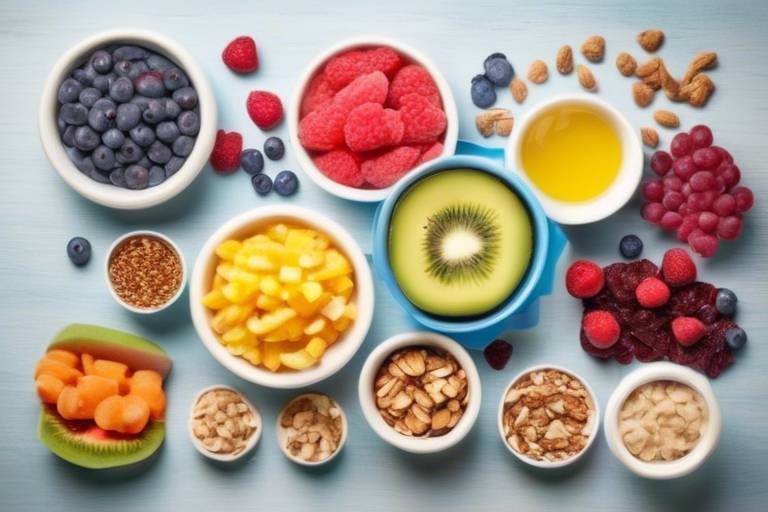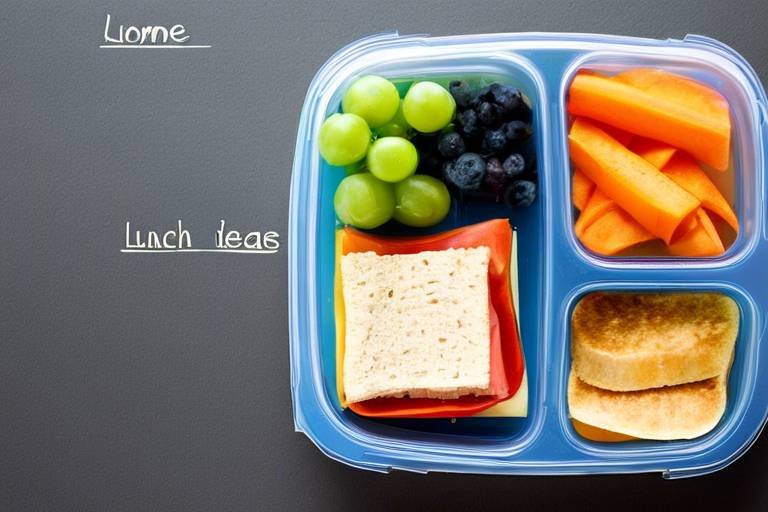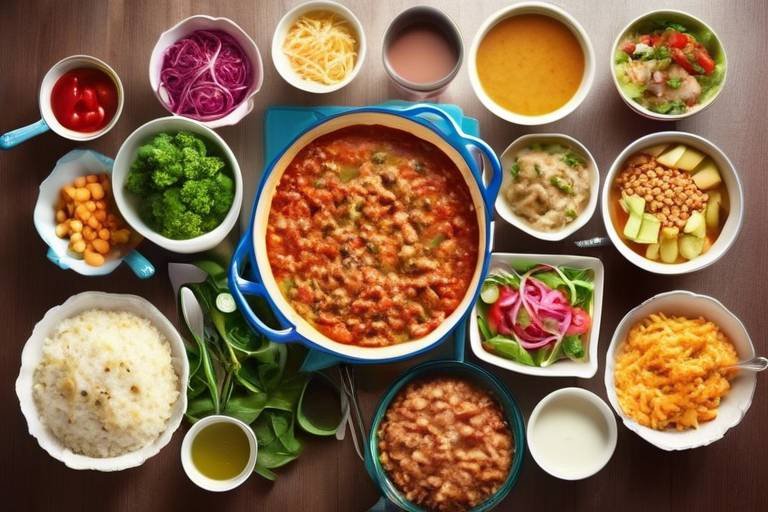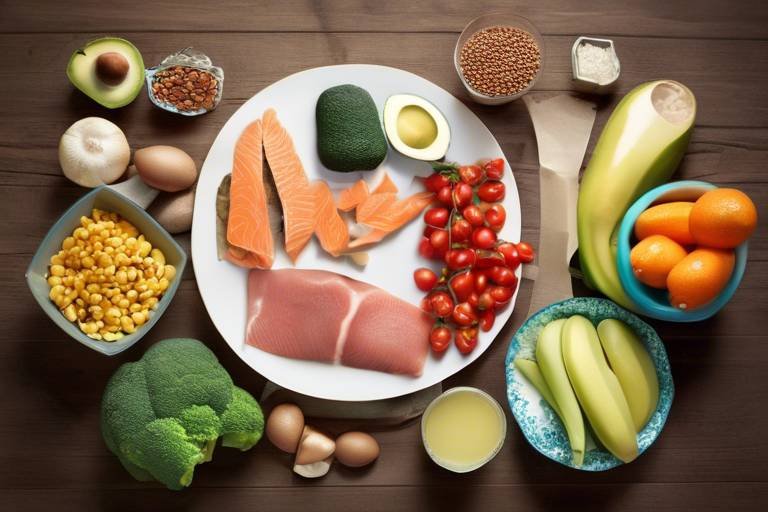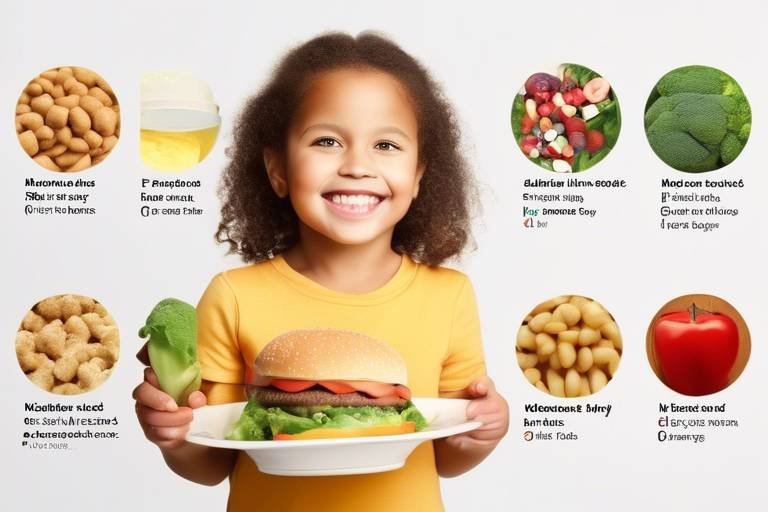Quick, Cheap, and Nutritious Meals for the Whole Family
In today's fast-paced world, finding the balance between healthy eating and a busy lifestyle can feel like a daunting task. But fear not! This article explores a treasure trove of meal options that are not only budget-friendly and nutritious, but also quick to prepare. Imagine coming home after a long day, and instead of succumbing to takeout, you whip up a delicious, wholesome meal in no time. That’s the magic we’re aiming for!
Cooking for the family shouldn't feel like an Olympic event. With a little creativity and some strategic planning, you can enjoy healthy meals without spending hours in the kitchen or breaking the bank. So, let’s dive into the world of quick, cheap, and nutritious meals that will keep your family happy and healthy!
When you think about quick meals, what comes to mind? For many, it’s the promise of saving time and reducing stress. Quick meals allow families to spend more quality moments together, whether it's sitting down for dinner or enjoying a movie night. Imagine the relief of knowing that dinner is ready in just 20 minutes, leaving you more time to connect with your loved ones. Plus, they are a lifesaver during busy weeknights when the last thing you want to do is spend hours cooking.
Moreover, quick meals make it easier to maintain a healthy diet amidst a hectic schedule. They allow you to dodge the temptation of unhealthy fast food options. Instead, you can prepare meals that are not only nourishing but also packed with flavor. It's like having your cake and eating it too—only in this case, the cake is a delicious, healthy stir-fry!
Utilizing affordable ingredients is key to creating nutritious meals without compromising on flavor. When shopping, think of staples that can serve as the foundation for various recipes. Here’s a quick rundown of some budget-friendly staples that can easily become your kitchen heroes:
- Whole Grains: Whole grains like brown rice, quinoa, and whole wheat pasta are not only nutritious but also filling. They provide essential fibers and nutrients that keep everyone satisfied.
- Seasonal Vegetables: Using seasonal veggies not only reduces costs but also ensures that your meals are fresh and bursting with flavor.
- Proteins: Affordable proteins such as beans, lentils, and eggs can be the stars of your meals, adding both nutrition and taste.
Whole grains are a fantastic source of fiber and essential nutrients. Incorporating options like brown rice, quinoa, and whole wheat pasta can significantly enhance the nutritional value of family meals without breaking the bank. For instance, a simple quinoa salad mixed with seasonal vegetables can be a delightful dish that the entire family will love.
Rice dishes are incredibly versatile and easy to prepare. From stir-fries to casseroles, rice can be customized with various vegetables and proteins to create balanced meals. Picture a colorful vegetable stir-fry served over a bed of fluffy brown rice—it's not just a meal; it's a feast for the eyes and the palate!
Pasta is a family favorite that can be made quickly and affordably. With simple sauces and seasonal vegetables, you can transform a basic pasta dish into a nutritious meal packed with flavor. Think of a creamy tomato sauce enriched with spinach and topped with grilled chicken—delicious, right?
Using seasonal vegetables not only reduces costs but also ensures freshness and flavor. Incorporating these vibrant veggies into quick meals can elevate your dishes. For example, a stir-fry with bell peppers, broccoli, and snap peas can be a delightful explosion of colors and tastes on your dinner table!
Meal prepping can streamline weeknight dinners and save you from the last-minute scramble. Imagine opening your fridge to find prepped ingredients ready to go! Here are some simple strategies for preparing ingredients in advance:
Batch cooking allows families to prepare large quantities of meals at once, saving time and ensuring that nutritious options are readily available throughout the week. You can cook a big pot of chili or a hearty vegetable soup on the weekend, portion it out, and have healthy meals ready to go!
Freezer-friendly meals are a lifesaver for busy families. Think about recipes that can be made in bulk and stored for later. A classic lasagna or a vegetable curry can be made ahead of time and frozen, providing quick and nutritious options when time is tight. Just pop it in the oven, and voilà—dinner is served!
Now, let's get to the fun part—delicious recipes that are quick, nutritious, and sure to please the whole family. Each recipe is designed to be simple, affordable, and packed with flavor.
One-pot meals are ideal for busy nights. These recipes require minimal preparation and cleanup, making them a convenient option for families looking for quick and nutritious dinners. Imagine a one-pot chicken and vegetable stew simmering away, filling your home with mouth-watering aromas!
Stir-frys are a fast and healthy way to incorporate a variety of vegetables and proteins. With just a few ingredients, you can whip up a delicious stir-fry in under 30 minutes. Toss in your favorite veggies, some protein, and a splash of soy sauce, and you have a meal that’s both satisfying and nutritious!
Healthy snacks can keep the family energized between meals. Think about quick and nutritious snack ideas that are easy to prepare and perfect for both kids and adults. Some great options include:
- Fruit and Yogurt Parfaits: Layer yogurt with fresh fruits and a sprinkle of granola for a delicious snack.
- Veggie Sticks with Hummus: Crunchy veggies paired with creamy hummus make for a satisfying snack.
- Trail Mix: A mix of nuts, seeds, and dried fruits can provide a quick energy boost.
1. What are some quick meal ideas for busy weeknights?
You can try one-pot meals, stir-fries, or quick pasta recipes. These options are not only fast but also nutritious!
2. How can I make meals more affordable?
Focus on using budget-friendly ingredients like whole grains, seasonal vegetables, and affordable proteins. Planning your meals around these staples can help save money.
3. What are some healthy snacks for kids?
Healthy snacks can include fruit and yogurt parfaits, veggie sticks with hummus, or homemade trail mix. These options are nutritious and enjoyable!

Benefits of Quick Meals
In our fast-paced world, quick meals have become a lifesaver for families juggling busy schedules. Imagine coming home after a long day, feeling exhausted, and the last thing you want to do is spend hours in the kitchen. This is where the magic of quick meals comes in! Not only do they save you precious time, but they also allow for more quality moments with your loved ones. Instead of slaving away over a hot stove, you can whip up a nutritious meal in no time, leaving you free to enjoy dinner together, share stories, or even play a game.
Quick meals also help to reduce the stress that often accompanies dinner preparation during hectic weeknights. When you have a plan for speedy meals, you can avoid the dreaded “What’s for dinner?” panic. This means you’re less likely to resort to unhealthy takeout or pre-packaged meals that can be high in calories and low in nutrients. Instead, you can focus on maintaining a healthy diet that fuels your family without breaking the bank or your sanity.
Moreover, quick meals can be both nutritious and delicious. They allow you to incorporate a variety of ingredients, ensuring your family receives a balanced diet rich in vitamins and minerals. Think about it: a simple stir-fry can be packed with colorful vegetables, lean proteins, and whole grains, all cooked up in under 30 minutes! The flexibility of quick meals means you can experiment with different flavors and ingredients, keeping mealtime exciting and satisfying.
Here are some of the key benefits of quick meals:
- Time-Saving: Prepare meals in 30 minutes or less.
- Stress Reduction: Eliminate the pressure of last-minute cooking.
- Healthier Choices: Control ingredients for a balanced diet.
- Family Bonding: More time to enjoy meals together.
In conclusion, the benefits of quick meals extend far beyond just saving time. They contribute to a healthier lifestyle, reduce stress, and create opportunities for families to bond. So, the next time you’re feeling overwhelmed, remember that a quick, nutritious meal could be just what you need to make your evening a success!

Budget-Friendly Ingredients
When it comes to feeding a family on a budget, the key lies in selecting affordable ingredients that are both nutritious and versatile. By focusing on staple items that can be used in various recipes, you can create delicious meals without putting a strain on your wallet. Imagine walking into your kitchen and knowing that you have everything you need to whip up a healthy dinner without making an emergency trip to the grocery store. Sounds great, right? Let's explore some of the best budget-friendly ingredients that can help you achieve this!
One of the most important categories to consider is whole grains. Whole grains are not just filling; they’re also packed with fiber and essential nutrients. Consider incorporating options like brown rice, quinoa, and whole wheat pasta into your meals. These ingredients can serve as the foundation for a variety of dishes, from hearty grain bowls to satisfying pasta meals. For example, a simple stir-fry with brown rice can be a nutritious option that the whole family will enjoy.
Another fantastic option is seasonal vegetables. Utilizing what's in season not only helps to save money but also ensures that you’re getting the freshest produce available. Seasonal veggies are bursting with flavor and can elevate any meal. For instance, during the summer months, zucchini and bell peppers are often abundant and can be easily tossed into a stir-fry or roasted as a side dish. When you plan your meals around these vegetables, you’ll find that you can create exciting dishes without breaking the bank.
To give you a better idea of how to utilize these budget-friendly ingredients, here’s a simple table that outlines some common staples and their benefits:
| Ingredient | Benefits |
|---|---|
| Brown Rice | High in fiber, aids digestion, and keeps you full longer. |
| Quinoa | Complete protein source, gluten-free, and rich in vitamins. |
| Whole Wheat Pasta | Higher in fiber than regular pasta, helps regulate blood sugar. |
| Seasonal Veggies | Fresh, flavorful, and often cheaper; packed with nutrients. |
In addition to whole grains and seasonal vegetables, don’t overlook the power of legumes like beans and lentils. These ingredients are not only budget-friendly but also incredibly nutritious. They can be used in soups, salads, or as a protein source in various dishes. Plus, they are easy to prepare in bulk and can be frozen for future use. Imagine making a big pot of lentil soup on a Sunday and having it available for quick lunches or dinners throughout the week.
Lastly, consider incorporating frozen fruits and vegetables into your meals. They are often just as nutritious as their fresh counterparts and can be a lifesaver when you're in a pinch. Just think of those busy weeknights when you can quickly toss some frozen spinach into an omelet or blend frozen berries into a smoothie without having to worry about spoilage.
By focusing on these budget-friendly ingredients, you can create meals that are not only quick and easy to prepare but also nutritious and satisfying. The key is to get creative with these staples and mix and match them to keep your family’s meals exciting and diverse. So, roll up your sleeves, head to the kitchen, and let’s make healthy eating a reality for your family!

Whole Grains
Whole grains are a powerhouse of nutrition, providing essential vitamins, minerals, and fiber that are crucial for maintaining a healthy diet. When you think about it, incorporating whole grains into your family's meals is like adding a secret ingredient that boosts both health and flavor without breaking the bank. Imagine brown rice, quinoa, and whole wheat pasta as the unsung heroes of your pantry—affordable yet packed with goodness. These grains not only fill you up but also keep your digestive system happy, making them a smart choice for busy families looking to eat well.
One of the best things about whole grains is their versatility. You can use them in a variety of dishes, from hearty salads to comforting casseroles. For instance, brown rice can be the base for a delicious stir-fry, while quinoa can be tossed into a salad for a protein boost. Whole wheat pasta can be dressed up with fresh vegetables and a light sauce, creating a meal that's both satisfying and nutritious. The options are endless, and they all come together to create a balanced diet that doesn't feel like a chore to prepare.
Moreover, whole grains are incredibly easy to cook. Most can be prepared in less than 30 minutes, making them perfect for those hectic weeknights when you need to get dinner on the table fast. Just think about it: a quick boil or steam, and you have a nutritious base for your meal ready to go. You can even batch cook grains ahead of time, storing them in the fridge for easy access throughout the week. This way, you can whip up a healthy meal in no time, leaving you more moments to spend with your family.
Incorporating whole grains into your meals is not just about health; it’s also about flavor and satisfaction. The nutty taste and chewy texture of whole grains can elevate a simple dish, making it more enjoyable for everyone at the table. So why not make whole grains a staple in your kitchen? They are not just a side dish; they can be the star of the show.
To help you get started, here’s a quick comparison of some popular whole grains to consider for your meals:
| Whole Grain | Cooking Time | Health Benefits |
|---|---|---|
| Brown Rice | 30-40 minutes | High in fiber, aids digestion |
| Quinoa | 15-20 minutes | Complete protein, gluten-free |
| Whole Wheat Pasta | 8-10 minutes | Rich in fiber, helps maintain blood sugar |
When you choose whole grains, you’re not just making a healthy choice; you’re also setting an example for your family about the importance of nutritious eating. So, let’s embrace these incredible grains and transform our meals into something that’s quick, cheap, and oh-so-nutritious!
Q: What are whole grains?
A: Whole grains are grains that contain all parts of the grain kernel, including the bran, germ, and endosperm. Examples include brown rice, quinoa, and whole wheat products.
Q: Why should I include whole grains in my diet?
A: Whole grains are packed with nutrients, including fiber, vitamins, and minerals. They can help improve digestion, lower cholesterol levels, and provide sustained energy.
Q: How can I incorporate whole grains into my meals?
A: You can add whole grains to salads, stir-fries, soups, and casseroles. They can also be used as a base for grain bowls or as a side dish.
Q: Are whole grains more expensive than refined grains?
A: Whole grains can be cost-effective, especially when bought in bulk. They also provide more nutritional value, making them a better investment for your health.

Rice Dishes
Rice dishes are a fantastic way to bring families together around the dinner table. They are not only versatile but also incredibly easy to prepare, making them a go-to option for busy weeknights. Imagine a steaming bowl of rice, fluffy and warm, waiting to be paired with your favorite vegetables and proteins. The beauty of rice lies in its ability to absorb flavors, transforming even the simplest ingredients into a delicious meal.
Whether you’re whipping up a quick stir-fry, a hearty casserole, or a comforting rice bowl, there are endless possibilities to explore. One of the best things about rice is that it can be a blank canvas for your culinary creativity. For instance, you can easily mix and match ingredients based on what you have on hand. Here are a few ideas to get you started:
- Stir-Fried Rice: A quick and satisfying option that allows you to use leftover vegetables and proteins. Just toss everything in a pan with some soy sauce, and you have a meal ready in minutes!
- Rice Casseroles: Combine cooked rice with a protein source like chicken or beans, add some vegetables, and top it off with cheese for a comforting dish that the whole family will love.
- Rice Bowls: Layer cooked rice with your choice of toppings, such as grilled chicken, sautéed veggies, and a drizzle of sauce for a balanced and nutritious meal.
To make your rice dishes even more nutritious, consider incorporating a variety of vegetables. Seasonal produce not only enhances the flavor but also adds vibrant colors to your meal, making it more appealing to kids and adults alike. For example, bell peppers, broccoli, and carrots can all be easily tossed into a rice dish, providing essential vitamins and minerals.
Moreover, you can elevate your rice dishes by experimenting with different types of rice. Brown rice, for instance, offers more fiber and nutrients compared to white rice. Quinoa, while technically a seed, can also be a delightful alternative that packs a protein punch. With these options, you can cater to various dietary needs while keeping meals exciting.
In summary, rice dishes are an excellent way to create quick, cheap, and nutritious meals for the whole family. They allow you to be creative in the kitchen without sacrificing health or flavor. So next time you’re in a pinch for dinner ideas, remember the humble grain that can transform your meal into something truly delightful!
Q: How can I make rice dishes more flavorful?
A: You can enhance the flavor of rice dishes by using broth instead of water for cooking, adding herbs and spices, or incorporating sauces like soy sauce or teriyaki.
Q: What are some quick protein options to add to rice dishes?
A: Quick protein options include pre-cooked chicken, canned beans, tofu, or even scrambled eggs, all of which can be added to your rice dishes in no time.
Q: Can I prepare rice dishes in advance?
A: Absolutely! Rice dishes can be made in advance and stored in the refrigerator for a few days. Just reheat and enjoy!

Pasta Recipes
Pasta is more than just a staple; it's a canvas for creativity, a comfort food that can be tailored to suit any palate, and a quick meal solution that won't break the bank. Imagine coming home after a long day, the kids are restless, and the clock is ticking. What do you need? A delicious pasta dish that can be whipped up in a flash! With a few simple ingredients, you can transform a basic pasta meal into a culinary delight that the whole family will love.
One of the best things about pasta is its versatility. You can pair it with a variety of sauces, proteins, and vegetables to create unique flavors. For instance, a simple tomato sauce can be elevated with the addition of garlic, herbs, and a sprinkle of cheese. Or consider a creamy alfredo sauce made with just a handful of ingredients like butter, cream, and parmesan cheese. The options are endless! Here are a few quick ideas to get you started:
- Spaghetti Aglio e Olio: This classic Italian dish requires just spaghetti, garlic, olive oil, and a pinch of red pepper flakes. It's quick, simple, and utterly delicious.
- Pasta Primavera: Toss your favorite seasonal vegetables with pasta and a light olive oil dressing for a fresh, vibrant meal.
- One-Pot Pasta: Cook pasta with your choice of protein and vegetables in a single pot. Everything cooks together, soaking up all the flavors!
Incorporating seasonal vegetables not only enhances the nutritional profile of your pasta dishes but also adds a splash of color and freshness. Think about adding broccoli, bell peppers, or zucchini to your pasta. Not only do they taste great, but they also provide essential vitamins and minerals that are crucial for your family's health.
If you're looking to make your pasta dishes even more nutritious, consider using whole grain pasta. Whole wheat or legume-based pasta options are packed with fiber and nutrients, providing a heartier meal that will keep everyone satisfied longer. Plus, they pair beautifully with a variety of sauces and toppings.
As you experiment with different pasta recipes, don't be afraid to get creative! Add spices, herbs, or even a splash of lemon juice to brighten up the flavors. The key is to keep it simple and enjoyable. After all, the goal is to make mealtime a delightful experience for your family, not a chore.
1. How can I make pasta dishes healthier?
You can make pasta dishes healthier by using whole grain pasta, adding plenty of vegetables, and opting for lighter sauces like tomato or olive oil instead of heavy cream-based sauces.
2. What are some quick pasta sauces I can make?
Some quick pasta sauces include marinara sauce, garlic and oil (Aglio e Olio), pesto, or a simple cream sauce made with butter, cream, and cheese.
3. Can I prepare pasta in advance?
Absolutely! You can cook pasta in advance and store it in the fridge for a few days. Just be sure to toss it with a bit of olive oil to prevent sticking.
4. What proteins can I add to pasta dishes?
Common proteins that pair well with pasta include grilled chicken, shrimp, ground turkey, or even beans for a vegetarian option.
5. How long does it take to cook pasta?
Most pasta types take between 8 to 12 minutes to cook, depending on the thickness. Always refer to the package instructions for the best results.

Seasonal Vegetables
Using in your meals is like opening a treasure chest of flavors and nutrients. These vibrant veggies not only taste better when they're in season, but they also come at a lower price point, making them a smart choice for budget-conscious families. Imagine biting into a juicy, sun-ripened tomato or a crisp, sweet bell pepper—there’s nothing quite like it! When you choose seasonal produce, you're not just saving money; you're also supporting local farmers and reducing your carbon footprint by minimizing transportation costs.
So, how do you know what’s in season? It varies by region, but generally, spring brings a bounty of greens like asparagus and peas, summer is bursting with tomatoes, zucchini, and corn, while fall showcases root vegetables like squash, carrots, and beets. Winter, on the other hand, offers hardy greens and cruciferous vegetables such as kale and Brussels sprouts. Incorporating these seasonal delights into your meals can elevate even the simplest dishes.
Let's take a closer look at some of the benefits of using seasonal vegetables:
- Improved Flavor: Seasonal produce is picked at its peak ripeness, providing a richer taste compared to out-of-season options.
- Higher Nutritional Value: Freshly harvested vegetables retain more nutrients, making your meals healthier.
- Cost-Effective: Buying in season often means lower prices, allowing you to stretch your grocery budget further.
- Environmental Benefits: Supporting local farmers and reducing transportation emissions helps protect our planet.
To make the most of seasonal vegetables, consider creating a simple stir-fry or a hearty vegetable soup. For instance, a summer vegetable medley with zucchini, bell peppers, and corn sautéed in olive oil can be both quick and delicious. Alternatively, a fall root vegetable roast with carrots, sweet potatoes, and beets drizzled with honey and thyme can warm your family’s hearts and bellies. The possibilities are endless!
Incorporating seasonal vegetables into your meals not only enhances the flavor but also makes your cooking experience more enjoyable. So, next time you’re at the grocery store or farmers' market, take a moment to explore what’s in season. Your taste buds—and your wallet—will thank you!
Q1: How can I find out what vegetables are in season?
A1: You can check local farmers' markets, agricultural extension services, or online resources that provide seasonal produce guides specific to your region.
Q2: Are frozen vegetables as nutritious as fresh seasonal ones?
A2: Frozen vegetables can be a great alternative, as they are often frozen at peak ripeness, preserving their nutrients. However, fresh seasonal vegetables typically offer better flavor and texture.
Q3: How can I incorporate more seasonal vegetables into my diet?
A3: Start by planning your meals around seasonal produce, experimenting with new recipes, and visiting local markets to discover what's available. You can also try growing your own vegetables if you have the space!

Easy Meal Prep Ideas
Meal prepping is like having a secret weapon in your kitchen arsenal. Imagine this: it’s a busy weeknight, and instead of scrambling to throw together dinner, you open your fridge to find prepped ingredients just waiting to be transformed into a delicious meal. Sounds dreamy, right? With a little planning and creativity, you can streamline your weeknight dinners and enjoy nutritious meals without the stress. Let’s dive into some practical strategies that can help you become a meal prep pro!
One effective method is batch cooking. This technique involves preparing large quantities of meals at once, which can then be stored for later use. Think of it as cooking in bulk! For instance, you could whip up a big pot of chili or a hearty vegetable soup on the weekend. Not only does this save time, but it also ensures you have healthy options readily available throughout the week. When you’re feeling hungry, simply reheat a portion, and voilà—dinner is served!
Another fantastic idea is to focus on freezer-friendly meals. These meals are a lifesaver for busy families! You can prepare dishes in bulk and freeze them for those nights when time is tight. Popular options include casseroles, stews, and even homemade burritos. Just imagine coming home after a long day and having a nutritious meal ready to go. To help you get started, here’s a quick table of some freezer-friendly meals you might consider:
| Meal | Preparation Time | Freezing Tips |
|---|---|---|
| Vegetable Lasagna | 60 minutes | Wrap tightly in foil; label with date. |
| Chicken Stir-Fry | 30 minutes | Cool completely before freezing; use airtight containers. |
| Beef Stew | 90 minutes | Freeze in portions for easy reheating. |
Now, let’s talk about prepping ingredients. This can be a game changer! Spend a little time on the weekend chopping vegetables, marinating proteins, or even cooking grains like quinoa or brown rice. You can store these prepped ingredients in clear containers in your fridge, making it easy to grab and go during the week. When you have everything ready to go, whipping up a quick meal becomes a breeze. You can mix and match these ingredients to create various dishes, keeping meals exciting and flavorful.
For example, you could have roasted veggies, grilled chicken, and cooked quinoa on hand. With just a few minutes of assembly, you can create a vibrant grain bowl topped with your favorite dressing. Or perhaps you want to toss those roasted veggies into a whole wheat wrap with some hummus for a quick lunch. The possibilities are endless!
Lastly, don't forget the power of theme nights. This is a fun way to keep meal prep interesting and engaging for the whole family. For instance, you could designate a night for tacos, where you prep all the fixings in advance. Everyone can build their own tacos, making it a fun family activity. This approach not only saves time but also encourages everyone to get involved in the meal process, making it a delightful experience.
- How long can I keep meal-prepped food in the fridge?
Generally, meal-prepped food can last in the fridge for about 3 to 4 days. If you want to keep it longer, consider freezing it. - Can I meal prep for breakfast?
Absolutely! Overnight oats, smoothie packs, and egg muffins are great breakfast options that can be prepped in advance. - What are some easy snacks to prep?
Prepping snacks like cut-up fruits, veggie sticks with hummus, or yogurt cups can keep everyone satisfied between meals.

Batch Cooking
Batch cooking is a game-changer for families looking to save time in the kitchen while still enjoying nutritious meals. Imagine coming home after a long day, only to be greeted by the delicious aroma of a home-cooked meal waiting for you. That’s the magic of batch cooking! By dedicating a few hours on the weekend or your day off, you can prepare large quantities of food that can be easily stored and reheated throughout the week. This not only cuts down on daily cooking time but also helps you avoid the temptation of unhealthy takeout options.
One of the best aspects of batch cooking is its versatility. You can cook a variety of dishes that cater to your family's preferences and dietary needs. Think about it: you could whip up a hearty chili, a flavorful vegetable curry, or a protein-packed casserole. The options are endless! Plus, by cooking in bulk, you can take advantage of seasonal ingredients and sales on staple items, making it a budget-friendly approach.
To get started with batch cooking, consider these simple steps:
- Plan Your Meals: Choose recipes that share similar ingredients to minimize waste and simplify your shopping list.
- Set Aside Time: Dedicate a specific day for cooking. This could be a Sunday afternoon or any day that fits your schedule.
- Invest in Quality Containers: Use airtight containers to store your meals. This ensures freshness and makes reheating a breeze.
Here’s a quick example of a batch cooking plan for the week:
| Day | Meal | Prep Time |
|---|---|---|
| Monday | Vegetable Stir-Fry | 30 minutes |
| Tuesday | Chili | 1 hour |
| Wednesday | Quinoa Salad | 20 minutes |
| Thursday | Pasta Bake | 45 minutes |
| Friday | Curry | 1 hour |
By following this simple structure, you can ensure that your family enjoys a variety of healthy meals throughout the week without the daily stress of cooking. And let’s face it, who wouldn’t want to spend less time in the kitchen and more time with loved ones?
In conclusion, batch cooking is not just a time-saver; it's a lifestyle choice that promotes healthier eating and family bonding. So, roll up your sleeves, gather your ingredients, and start batch cooking today! Your future self will thank you.

Freezer-Friendly Meals
When life gets hectic, having on hand can be a game changer for busy families. Imagine coming home after a long day, exhausted and hungry, only to find a delicious homemade meal waiting for you in the freezer. It’s like having a personal chef who magically appears just when you need them! By preparing meals in advance and freezing them, you not only save time but also ensure that your family has access to healthy and nutritious options without resorting to takeout.
So, what exactly makes a meal freezer-friendly? Generally, these meals are designed to withstand the freezing process without losing their flavor or texture. Dishes like soups, stews, casseroles, and even certain pasta dishes freeze exceptionally well. For instance, a hearty chicken and vegetable casserole can be assembled, frozen, and baked straight from the freezer on a busy night. Just pop it in the oven, and in no time, you’ll have a warm, comforting meal that feels like a hug on a plate!
To help you get started, here are some popular freezer-friendly meal ideas:
- Chili: A big batch of chili can be portioned into containers and frozen. It’s perfect for a quick meal and can be spiced up with toppings like cheese or avocado when served.
- Vegetable Soup: Packed with nutrients, a vegetable soup can be a great way to use up leftover veggies. Just blend, portion, and freeze!
- Meatballs: These versatile bites can be made in bulk, frozen, and served with pasta, in sandwiches, or on their own with a dipping sauce.
- Stir-Fry Kits: Chop up your favorite vegetables and proteins, toss them in a freezer bag with your choice of sauce, and freeze. When you’re ready to eat, just stir-fry them in a pan for a quick meal.
When storing these meals, it’s essential to use airtight containers or freezer bags to prevent freezer burn. Labeling each container with the date and contents can save you from the dreaded 'mystery meal' syndrome later on. You’ll be amazed at how much time and stress you can save by having a few of these meals tucked away in your freezer!
In conclusion, are a fantastic solution for families who want to eat healthy without sacrificing their time. With a little planning and preparation, you can enjoy delicious home-cooked meals even on the busiest of nights. So why not take a few hours this weekend to prepare some meals for the week ahead? Your future self (and your family) will thank you!
1. How long can I keep meals in the freezer?
Most cooked meals can be stored in the freezer for about 3-6 months, but for the best quality, try to consume them within 2-3 months.
2. Can I freeze raw meat and vegetables?
Yes, you can freeze raw meat and vegetables. Just be sure to package them properly to avoid freezer burn.
3. Do I need to thaw meals before cooking them?
While some meals can be cooked directly from the freezer, others may require thawing overnight in the refrigerator for best results.
4. What meals freeze best?
Soups, stews, casseroles, and pasta dishes generally freeze well. Avoid freezing meals with high water content, like salads, as they may become mushy when thawed.

Family-Friendly Recipes
When it comes to feeding the family, finding recipes that are not only quick and nutritious but also appealing to everyone can feel like searching for a needle in a haystack. But fear not! We've got some fantastic family-friendly recipes that will make your mealtime a breeze. Imagine sitting down to a table filled with vibrant colors and enticing aromas, where every bite is a celebration of flavor and health. These recipes are designed to be simple, affordable, and above all, delicious!
One of the best ways to ensure your family enjoys their meals is to incorporate their favorite ingredients. For instance, consider preparing a One-Pot Chicken and Vegetable Rice. This dish combines tender chicken pieces with a mix of seasonal vegetables and whole grain rice, all cooked together in one pot. Not only does this save on cleanup time, but it also locks in flavors and nutrients. Plus, you can easily customize it based on what your family loves. Swap out the veggies for what’s in season or on sale, and you’ve got a winner!
Another crowd-pleaser is a Quick Veggie Pasta. Start with whole wheat pasta, which is full of fiber, and toss it with a simple homemade sauce made from canned tomatoes, garlic, and whatever veggies you have on hand. Spinach, zucchini, or bell peppers work beautifully here. This dish can be whipped up in under 30 minutes, making it perfect for those busy weeknights when everyone is rushing home. And if you want to take it up a notch, sprinkle some grated cheese on top before serving for that extra touch of yum!
For a fun twist on dinner, consider making Stir-Fried Tofu and Broccoli. Tofu is a fantastic source of protein and can be cooked quickly. Pair it with fresh broccoli and a splash of soy sauce, and you’ve got a colorful dish that’s packed with nutrients. Serve it over brown rice or quinoa for a complete meal. The best part? This dish is so versatile; you can easily swap out the tofu for chicken or shrimp if your family prefers meat!
To keep things interesting, why not try your hand at Homemade Pizza Night? This is not just a meal; it’s an experience! Set up a pizza-making station with whole wheat pizza bases and an array of toppings like tomato sauce, cheese, and various veggies. Let everyone create their personal pizza masterpiece. This not only makes for a fun family activity but also ensures that each person gets exactly what they want. Plus, you can sneak in some healthy toppings without anyone noticing!
And let's not forget about the power of One-Pan Baked Salmon and Asparagus. This dish is not only quick to prepare but also incredibly nutritious. Simply place salmon fillets and asparagus on a baking sheet, drizzle with olive oil, and season with your favorite herbs. Bake until the salmon is flaky and the asparagus is tender. This meal is not just healthy; it looks stunning on the plate, making it a great option for family dinners.
With these family-friendly recipes, you can create meals that are not only quick and easy but also packed with nutrition. The goal is to make mealtime enjoyable and stress-free, allowing you to focus on what really matters – spending quality time with your loved ones. So, roll up your sleeves, gather your ingredients, and get cooking!
Q: How can I make meal prep easier for my family?
A: Start by planning your meals for the week and prepping ingredients in advance. Chop vegetables, marinate proteins, and cook grains ahead of time. This will save you time during busy weeknights.
Q: What are some budget-friendly ingredients I can use?
A: Staples like whole grains (brown rice, quinoa), canned beans, seasonal vegetables, and frozen fruits are excellent choices. They are nutritious and often more affordable than fresh produce.
Q: How can I get my kids to eat more vegetables?
A: Involve them in the cooking process! Let them choose vegetables for recipes or help with meal prep. Making meals interactive can encourage them to try new things.
Q: Are there quick recipes for picky eaters?
A: Absolutely! Simple recipes like cheese quesadillas, pasta with butter and cheese, or smoothies with hidden fruits can be great options for picky eaters.

One-Pot Meals
When it comes to family dinners, are like the superheroes of the kitchen. They swoop in to save the day, providing a delicious and nutritious dinner with minimal fuss. Imagine a meal where all the flavors meld together, creating a harmonious dish that everyone in the family will love. Plus, the best part? You only have to clean one pot! This means less time scrubbing and more time enjoying your meal with your loved ones.
One-pot meals are incredibly versatile, allowing you to mix and match ingredients based on what you have on hand. You can throw in your favorite proteins, an array of colorful vegetables, and a hearty grain, all simmered in a single pot. This not only simplifies the cooking process but also ensures that your meal is packed with nutrients. Think of it as a culinary canvas where you can express your creativity while keeping things simple.
Here are a few popular one-pot meal ideas that are sure to please:
- One-Pot Chicken and Rice: A comforting classic, this dish combines tender chicken, fragrant spices, and fluffy rice, all cooked together to create a savory masterpiece.
- Vegetable and Quinoa Stew: Packed with seasonal vegetables and protein-rich quinoa, this stew is not only filling but also bursting with flavors.
- Beef and Broccoli Stir-Fry: Quick and easy, this dish brings together tender beef and vibrant broccoli in a savory sauce, served over rice or noodles.
To make your one-pot meals even more exciting, consider trying different cuisines. A Mexican-inspired one-pot dish might include black beans, corn, and spices, while an Italian version could feature pasta, tomatoes, and basil. The possibilities are endless! You can also adjust the spice levels to cater to your family's taste preferences, ensuring that everyone enjoys their meal.
In addition to being quick and easy, one-pot meals are also a great way to encourage family bonding. Involve your kids in the cooking process—let them stir the pot, sprinkle in the herbs, or measure out the ingredients. This not only makes cooking more fun but also teaches them valuable skills that they'll carry into adulthood.
In summary, one-pot meals are a fantastic solution for busy families looking to enjoy nutritious and delicious dinners without the hassle. They save time, reduce cleanup, and offer endless possibilities for creativity in the kitchen. So the next time you're wondering what to make for dinner, remember that the answer might just be a simple, satisfying one-pot meal!
Q: Can I prepare one-pot meals in advance?
A: Absolutely! Many one-pot meals can be prepared in advance and stored in the refrigerator or freezer. Just reheat when you're ready to eat.
Q: What are some tips for making one-pot meals healthier?
A: Incorporate plenty of vegetables, choose whole grains, and opt for lean proteins. You can also reduce the amount of salt and sugar by using herbs and spices for flavor.
Q: How do I adjust cooking times for different ingredients?
A: Cooking times can vary based on the ingredients you use. Start with the ingredients that take the longest to cook, like grains or root vegetables, and add quicker-cooking items later in the process.

Quick Stir-Frys
When it comes to whipping up a meal in a flash, stir-frys are your best friend! Not only are they incredibly quick to prepare, but they also allow you to pack in a variety of nutrients and flavors that your family will love. Imagine this: you come home after a long day, and all you want is something delicious and healthy, but you don’t want to spend hours in the kitchen. That’s where a stir-fry shines! With just a few ingredients and a hot pan, you can create a vibrant dish that’s as colorful as a painter’s palette.
The beauty of stir-frying lies in its versatility. You can use almost any vegetable or protein you have on hand. Whether it's bell peppers, broccoli, or even leftover chicken from last night’s dinner, everything can come together in a matter of minutes. Just chop your ingredients, toss them into a hot skillet or wok, and watch the magic happen. The high heat ensures that your vegetables retain their crunch and nutrients, while the quick cooking time keeps everything fresh and flavorful.
Here are a few tips to elevate your stir-fry game:
- Prep Ahead: Chop your vegetables and proteins beforehand. This way, when you’re ready to cook, all you need to do is toss them in the pan.
- Use a Variety of Colors: The more colorful your stir-fry, the more nutrients it typically contains. Think green broccoli, red bell peppers, and yellow carrots!
- Don’t Overcrowd the Pan: If you pack too many ingredients in, they’ll steam instead of fry. Work in batches if necessary.
- Flavor Boosters: Don’t forget to add sauces like soy sauce, teriyaki, or even a splash of sesame oil to enhance the flavor.
For a simple yet delicious stir-fry, try this quick recipe:
| Ingredients | Amount |
|---|---|
| Broccoli | 2 cups, chopped |
| Bell Peppers | 1 cup, sliced |
| Carrots | 1 cup, sliced |
| Chicken Breast | 1 lb, cubed |
| Soy Sauce | 2 tablespoons |
| Sesame Oil | 1 tablespoon |
Simply heat a tablespoon of sesame oil in a large skillet over medium-high heat. Add the chicken and cook until browned. Then, toss in your colorful veggies and stir-fry for about 5-7 minutes. Drizzle with soy sauce, give it a good stir, and voilà! You’ve got a quick, nutritious meal that’s ready to serve in under 20 minutes!
Stir-frys are not just about speed; they’re also a great way to introduce your family to new flavors and textures. Why not experiment with different sauces or try adding tofu for a vegetarian option? The possibilities are endless, and your family will appreciate the effort you put into keeping mealtime exciting.
Q: Can I use frozen vegetables for stir-frys?
A: Absolutely! Frozen vegetables are a convenient option and can be just as nutritious as fresh ones. Just make sure to thaw them slightly before cooking to avoid excess moisture.
Q: How can I make my stir-fry more filling?
A: You can add whole grains like brown rice or quinoa as a base for your stir-fry. This not only makes it more filling but also adds extra fiber and nutrients.
Q: What proteins work best in stir-frys?
A: Chicken, beef, shrimp, and tofu are all excellent choices. Just remember to cut them into small, uniform pieces for even cooking.

Healthy Snack Options
When it comes to keeping the family energized between meals, healthy snacks are an absolute game-changer. They not only curb hunger but also provide essential nutrients to fuel those busy days. Think of snacks as the little pit stops on your road trip of life; they help you refuel and keep going without derailing your journey toward a healthy lifestyle. But what makes a snack truly healthy? It’s all about the ingredients and how they fit into your overall diet. Here are some quick and nutritious snack ideas that are easy to prepare, delicious, and perfect for both kids and adults.
One of the simplest yet most satisfying snacks is fresh fruit. Fruits like apples, bananas, and berries are packed with vitamins and antioxidants. You can grab them on the go or pair them with a dollop of yogurt for a more filling option. For those who enjoy a bit of crunch, consider making a trail mix using nuts, seeds, and dried fruits. Not only is it nutritious, but it also offers a delightful combination of textures and flavors that can keep everyone satisfied until the next meal.
Another fantastic option is vegetable sticks paired with hummus or guacamole. Carrots, celery, and bell peppers are not only colorful but also rich in vitamins. Dipping them into a creamy spread adds a layer of flavor and makes them more appealing, especially for kids who might be a bit hesitant about eating their veggies. Additionally, you might want to try making overnight oats as a snack. By mixing rolled oats with milk or yogurt and letting them soak overnight, you create a delicious, nutritious snack that can be customized with various toppings like nuts, seeds, or fresh fruit.
Here’s a quick table summarizing some healthy snack options:
| Snack | Benefits | Preparation Time |
|---|---|---|
| Fresh Fruit | Rich in vitamins and antioxidants | 1 minute |
| Trail Mix | Provides healthy fats and protein | 5 minutes |
| Vegetable Sticks with Hummus | High in fiber and vitamins | 10 minutes |
| Overnight Oats | High in fiber and customizable | 5 minutes (plus soaking time) |
Incorporating these snacks into your family's routine can be a breeze. You can even involve the kids in the preparation process, turning snack time into a fun and educational activity. Ask them to help you choose fruits and vegetables at the grocery store or let them mix the ingredients for trail mix. This not only makes them more likely to eat healthy but also teaches them valuable skills about nutrition and cooking.
So, the next time you’re caught in a snack attack, remember that healthy options are just a few minutes away. With a little creativity and planning, you can keep your family fueled and happy without resorting to sugary or processed snacks. After all, healthy snacking is not just about keeping hunger at bay; it’s about fostering a love for nutritious foods that can last a lifetime.
Q: What are some quick healthy snacks for kids?
A: Some quick healthy snacks for kids include fresh fruit, yogurt, veggie sticks with hummus, and whole-grain crackers with cheese. These options are not only nutritious but also appealing to children.
Q: How can I make healthy snacks more appealing to my family?
A: To make healthy snacks more appealing, try involving your family in the preparation process, using colorful fruits and vegetables, and pairing them with dips or spreads they love.
Q: Are store-bought snacks healthy?
A: Some store-bought snacks can be healthy, but it’s essential to read the labels. Look for options with minimal ingredients, low sugar, and whole food components. Making snacks at home is often the healthiest choice.
Frequently Asked Questions
- What are some quick meal ideas for busy families?
Quick meal ideas for busy families include one-pot meals, stir-fries, and rice dishes. These options are not only fast to prepare but also allow you to incorporate a variety of ingredients, making them nutritious and satisfying for everyone.
- How can I make meals more budget-friendly?
To make meals more budget-friendly, focus on using affordable ingredients such as whole grains, seasonal vegetables, and proteins like beans or lentils. Planning your meals around what's on sale at the grocery store can also help you save money.
- What are some healthy snack options for kids?
Healthy snack options for kids include homemade trail mix, yogurt with fruit, and veggie sticks with hummus. These snacks are not only nutritious but also easy to prepare, keeping your kids energized between meals.
- How can meal prepping help my family?
Meal prepping can help your family by saving time during busy weeknights. By preparing ingredients in advance or cooking meals in bulk, you can ensure that nutritious options are always available, making it easier to maintain a healthy diet.
- What are some freezer-friendly meal ideas?
Freezer-friendly meal ideas include soups, casseroles, and pasta dishes. These meals can be made in large quantities and stored for later, providing quick and nutritious options when time is tight.
- Why should I use seasonal vegetables in my meals?
Using seasonal vegetables not only enhances the flavor of your dishes but also reduces costs. Seasonal produce is often fresher and more nutrient-dense, making it a great choice for quick and nutritious meals.




